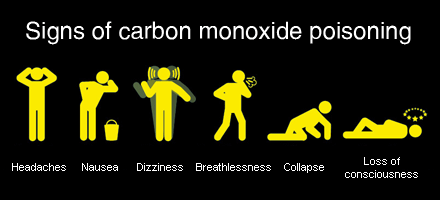The pathophysiology is a result of tissue hypoxia and direct toxicity at a cellular level. CO binds to hemoglobin with an affinity of over 200x that of oxygen. This binding results in a shift in the oxygen-dissociation curve to the left, meaning there is increased difficulty in extracting oxygen for tissue use. The increased affinity and tissue hypoxia cannot explain all of the effects of CO toxicity, and reactive oxygen species likely play a role. This is probably mediated through xanthine oxidase.

The clinical manifestations of CO poisoning can be subtle. Patients may be mistaken as having influenza (similar symptoms and both peak in winter months), presenting with headache, myalgias, confusion, tachypnea, tachycardia, presyncope and altered LOC. Classically, patients are described as having cherry red lips, though this is an insensitive sign. One retrospective study found the initial diagnosis to be listed as stroke, cardiac ischemia, encephalitis or seizure in multiple cases, highlighting the diagnostic challenge. Other acute symptoms include cardiac chest pain, and this has been described in 30% of cases. This is associated with increased mortality in CO poisoning. Chronic symptoms include the neuropsychiatric syndrome, which presents with personality changes, focal deficits, or cognitive impairment. This occurs with a month following poisoning and can persist for years. The mechanism is not clear, but may be related to myelin destruction from reactive oxygen species.
Because of the non-specific nature of CO poisoning a high index of suspicion is needed to make the diagnosis. The oxygen saturation on pulse oximetry is normal, given the maintained binding of hemoglobin. The diagnosis is made using co-oximetry to measure the amount of carboxyhemoglobin (venous or arterial blood). Amounts of carboxyhemoglobin can be found in several situations:
1-3% carboxyhemoglobin - Normal individuals
under 10% - smokers
Consider the patients history and presentation to determine if the levels are reasonable or as a result of poisoning.
The treatment of CO poisoning is emergency management.
1. ABC's - Many patients will have CO poisining from smoke inhalation. Security of the airway is crucial. Tachypnea, hypoventilation, stridor, facial blistering, burns and edema should prompt intubation and laryngoscopy. Patients can develop airway edema within 24 hours after the inhalation injury following thermal injury, this requires admission and monitoring for respiratory deterioration.
2. Oxygen therapy - all patients should receive high flow 100% oxygen. This results in rapid
improvement in CO levels compared to room air. The half life of CO is 300 minutes, and decreases to 90 minutes when supplimental oxygen is provided.
3. Consider hyperbaric oxygen therapy (HBOT) - Although this therapy is ubiquitous within the literature, the benefit of hyperbaric oxygen is somewhat controversial. There is no doubt that hyperbaric oxygen decreases the half life of oxygen even further than high FiO2 therapy, decreasing the half life to roughly 30 minutes. Whether this extends to improved long-term outcomes is debated. A cochrane review from 2011 found that further RCT's are required to determine whether HBOT should be offered, based on the poor quality of previous studies (see link below for details). Indications are variable, some directives suggests asymptomatic patients with a level of over 40% CO should have HBOT, while others say 25% is a reasonable cutoff. Other reasons to initiate HBOT are:
Pregnancy and CO level over 20%
Decreased LOC or new neurologic deficits
Myocardial ischemia
Acidosis (less than pH 7.1)
4. Isocapneic hyperventilation - this is an experimental treatment that doesn't seem to be widely used in the clinical setting. One study (actually affiliated with anaesthesia at the University of Toronto), showed that in dogs, hyperventilating while providing inhaled CO2 to maintain pH balance resulted in improved removal of CO.
Cochrane review on HBOT
4 comments :
Carbon monoxide (CO) poisoning is one of the most common sources of poisoning in North America. In a ten year period in the US, there was nearly 12,000 reported cases of death related to CO toxicity.
tb 500 peptide
Carbon monoxide (CO) poisoning is one of the most common sources of poisoning in North America. In a ten year period in the US, there was nearly 12,000 reported cases of death related to CO toxicity.
Peptides for sale
IGF1 LR3
Hi Friends i am so glad to writing this article today to tell the world how Dr voodoo cured my HSV VIRUS,i have been detected with HSV-1 AND HSV-2 since five years ago, ever since then my life has been in complete bizarre and agony,i have used so many drugs that was prescribed to me by several doctors,but it didn't cure my HSV VIRUS neither did it reduce the pain,until a certain i was checking for solution in the internet,then miraculously came across Dr voodoo the powerful herbalist that cure numerous individuals HSV-1 AND HSV-2 INFECTION,then i contacted his whatsApp number at +2348140120719 or email: voodoospelltemple66@gmail.com i explained everything to him and prepared a cure that cure my HSV-1 AND HSV-2 disease totally after receiving his herbal medicine, so my friends viewers why wait and be suffer when there is someone like Dr voodoo that can cure any disease HIV/ CANCER/ HEPATITIS B VIRUS, you can contact his via : voodoospelltemple66@gmail.com?. or WHATSAPP +2348140120719
I started on COPD Herbal treatment from Ultimate Health Home, the treatment worked incredibly for my lungs condition. I used the herbal treatment for almost 4 months, it reversed my COPD. My severe shortness of breath, dry cough, chest tightness gradually disappeared. Reach Ultimate Health Home via their website at www.ultimatelifeclinic.com I can breath much better and It feels comfortable!
Post a Comment